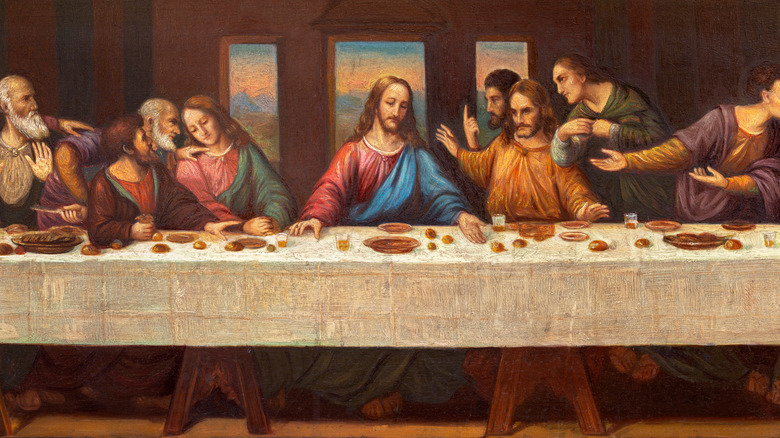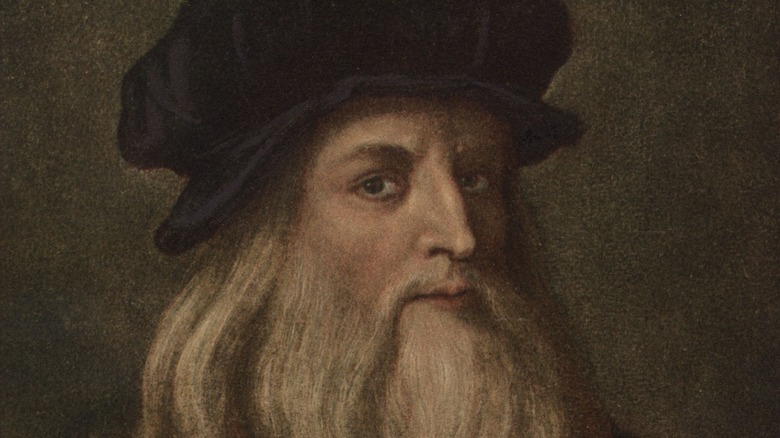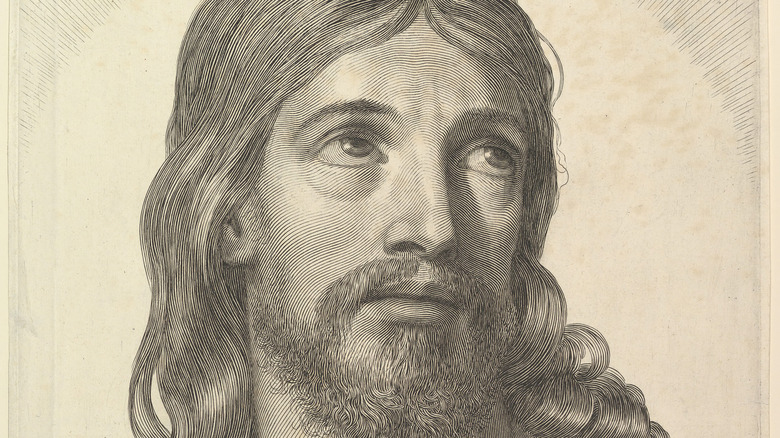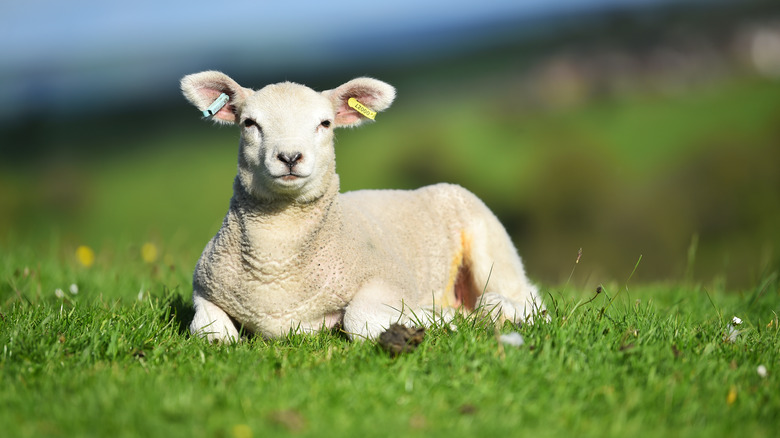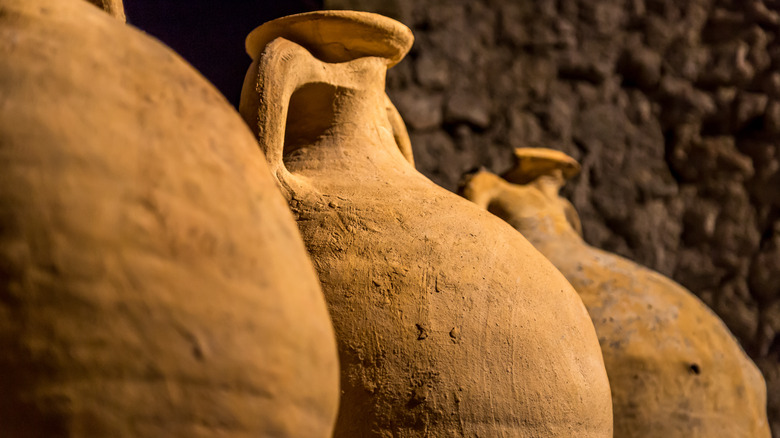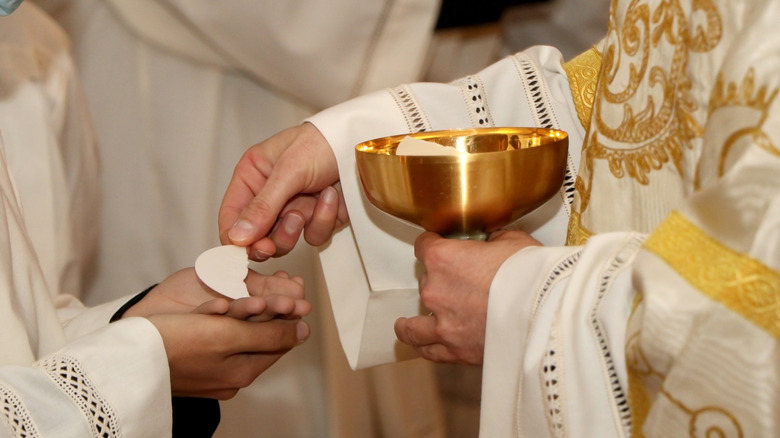This Is What Jesus Might Have Eaten At The Last Supper
One of the most iconic paintings of the High Renaissance period is Leonardo da Vinci's "Last Supper" (pictured above). The painting is renowned for its painter's mastery of perspective, the subtleties of human emotion depicted in the faces of the subjects, and possibly hidden meanings and secret codes.
Beyond the painting, the Last Supper itself — that is, the meal that Jesus and his apostles ate on his last night on Earth — is also of great significance to Christians. For example, at one point during the meal, Jesus broke a piece of bread and told the disciples, "This is my body, given to you" (Luke 22). Every Sunday, millions of Christians around the world commemorate this event by taking the Eucharist (or Communion, as some Christian traditions call it), as BBC News explains.
As to what Jesus and his disciples actually ate during the meal, beyond bread and wine, the text is woefully thin on details. However, due to archaeological, contextual, and historical clues, scholars think they have an idea of what Jesus and the disciples ate. While it may appear simple to modern readers, it was likely a major feast for the men who attended.
The painting gets just about everything wrong
Leonardo da Vinci (pictured above) can be forgiven for bungling some (or more accurately, almost all) of the historical details of the Last Supper in his painting of the event. After all, the Italian painter was almost certainly trying to show off his skill as an artist, and not trying to depict an accurate representation of what actually happened.
Among the myriad of things da Vinci got wrong, the two major ones are the setting and the way the men depicted are seated. In terms of the setting, Jesus and his disciples were almost certainly not in a luxurious Roman building. As the Israel Institute of Biblical Studies notes, they were in someone's home, in an "upper room" — likely a guest room, for which they might have even had to pay rent. And they wouldn't have been seated in chairs at a waist-high table, but rather reclining on cushions on the floor, their food on a low table, as WTSP explains.
There are minor inaccuracies, too. For example, the men would have eaten from plates and bowls made of stone, rather than metal or glass.
Jesus' regular diet would have been a mixed bag
Before delving too deeply into what Jesus and his disciples likely ate during the Last Supper, it helps to have a bit of insight into his day-to-day diet. Fortunately, it's rather easy to piece together what he ate.
Jesus was a poor Jew living in 1st-century Roman Palestine. As such, he'd have followed Jewish dietary laws, while eating modestly due to his financial limitations. Indeed, his diet was probably mostly bread, according to Faithward, topped with oil, honey, or salt whenever he could get it. Similarly, Dr. Oz notes that his diet would have included Middle Eastern foodstuffs such as dates, lentils, and nuts. Meat would have been a rare treat, though freshwater fish may have been in abundance, as some of Jesus' disciples were fishermen when he met them.
Of course, that's when Jesus and his disciples had money to buy food. There are times in his ministry when he likely faced malnutrition. For example, Matthew 12 records Jesus and his followers picking up sheaves of wild grain and threshing them with their hands in order to eat. Effectively, the men, unable to buy food, were foraging for it.
The Passover lamb
As previously mentioned, meat would have been a rare treat for Jesus and his disciples. However, for Jews like Jesus and his men, there was one annual occasion when having lamb at a meal was not optional: Passover. As the St. Paul Center for Biblical Theology explains, the Jewish feast of Passover commemorated an Old Testament event in which a sacrificial lamb played a role, and for the traditional Passover meal, a lamb was required.
Jesus and his disciples almost certainly had lamb at his Last Supper, and we know this for a couple of reasons. First, the event took place during the Passover season, meaning the Last Supper could very well have doubled as a Passover meal. What's more, Mark 14 is clear that Jesus instructed his disciples to prepare the meal, which, by necessity, would have included lamb.
So how could Jesus and his disciples have afforded meat and paid the rent on the space where they had their final meal? It's not known for certain, but it bears noting that Jesus and his disciples weren't always broke. Indeed, as CNN notes, they relied on donations to get by, and a couple of wealthy patrons are mentioned as contributing to the disciples' purse from time to time.
bean stew, dates, wine
The rest of Jesus' Passover meal would have included cheap and local ingredients that augmented the rare treat that was lamb meat, according to Live Science. And although no one can say with any certainty what was on the menu that night, two Italian archaeologists believe they have the general idea. Specifically, Generoso Urciuoli and Marta Berogno believe that the rest of the Last Supper, after the lamb, may have been bean stew (cholent), dates and nuts, olives with hyssop, and bitter herbs with pistachios and a date charoset (a chunky fruit and nut paste).
As for the drink, it was almost certainly wine, although the wine might not be recognizable to 21st-century fans of the grape. Specifically, it was likely aromatized wine. Though largely forgotten by modern vintners, the process, popular in ancient Rome, involved flavoring the wine with the addition of aromatics, according to Usual Wines. Those flavoring agents, at the time, could have included fruits, spices, and florals.
The enduring spiritual significance of the Last Supper
There are two lenses through which the Last Supper can be viewed: the Jewish lens and the Christian one. For Jews, Jesus' last meal was the ancient version of a ritual meal Jews still eat (called a seder) to celebrate Passover. Lamb has been off the menu since the 1500s, according to The New York Times, but with or without actual lamb meat, both Jesus' meal and a modern Jew's Passover meal both reference the Old Testament event in which a sacrificial lamb played a role.
For Christians, the meal is recreated metaphorically every Sunday (in Christian denominations that do so weekly). Communion, or the Eucharist as some denominations call it, involves worshippers consuming a small piece of bread, in honor of Jesus' body being broken, and a small gulp of wine, in honor of Jesus' blood being spilled. It's a tradition that began when Jesus instructed his disciples to do the same thing at the Last Supper, as Learn Religions notes.
